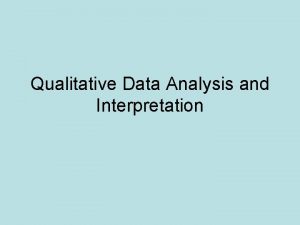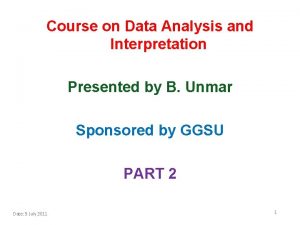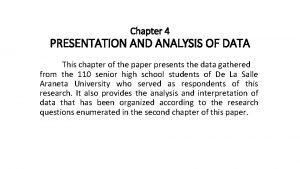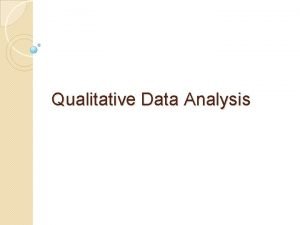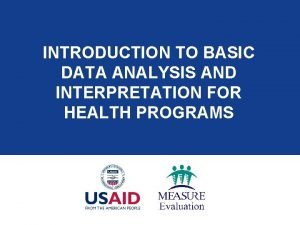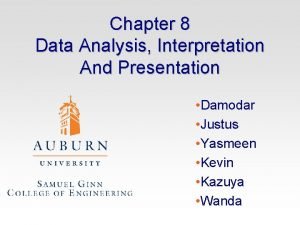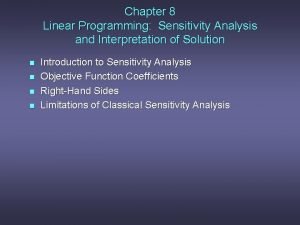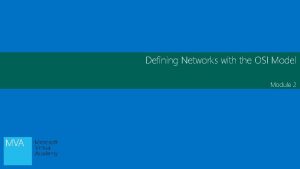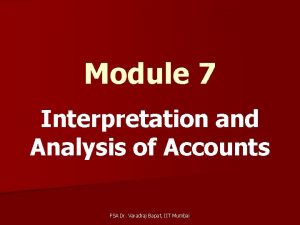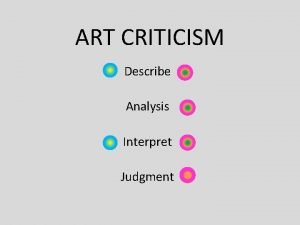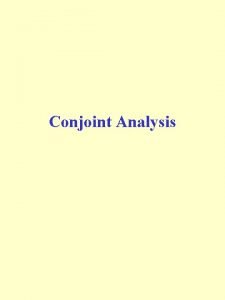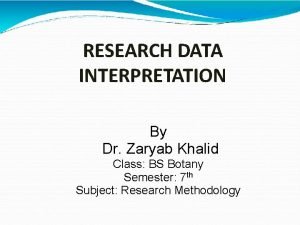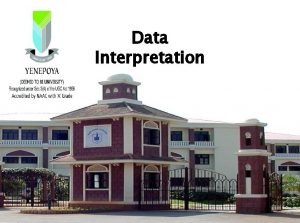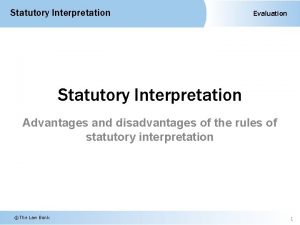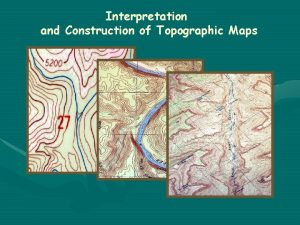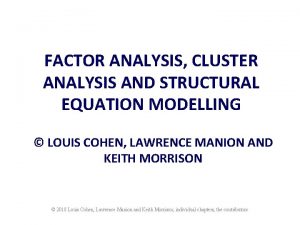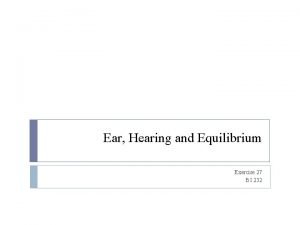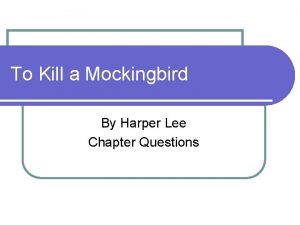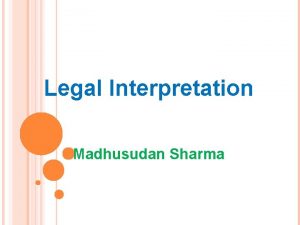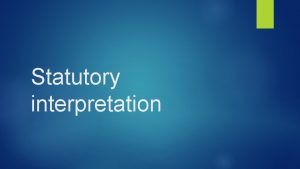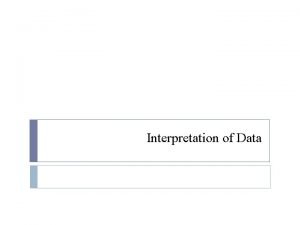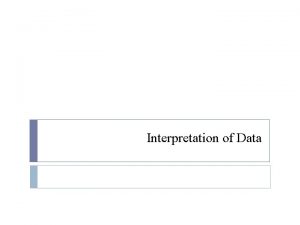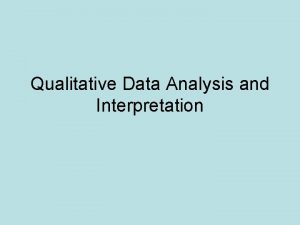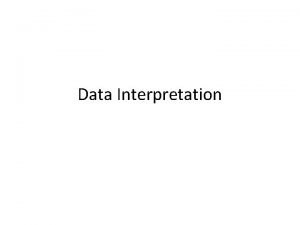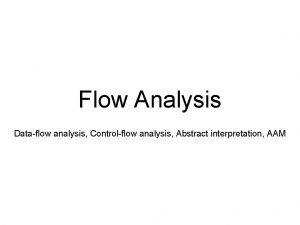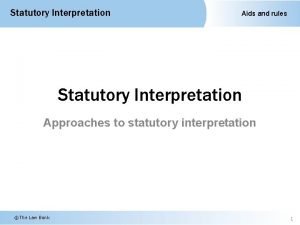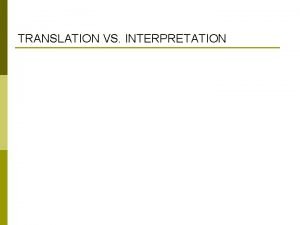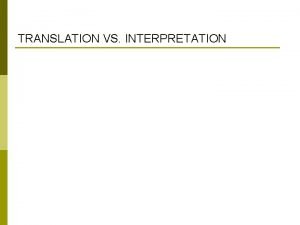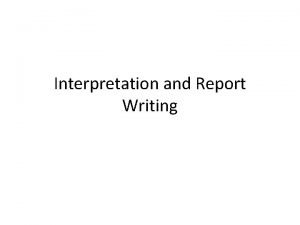Session 5 Data Analysis and Interpretation What are

































- Slides: 33

Session 5: Data Analysis and Interpretation 主讲人:韩玉梅

What are we going to talk in this lecture? I. Before data analysis: a review II. Data analysis and interpretation III. Analysis and interpretation in the field IV. Analysis and interpretation after data collection --Developing coding categories --Preassigned coding systems --Influences on coding and analysis V. The Mechanics of Working with Data VI. Computer and data analysis VII. Interpretation

I. Before Data Analysis: A Review l l l Fieldwork --Observation/Interview --Audio/Visual Recording Data collection --Fieldnotes --Transcripts --Photos --Documents What are you going to do with the data? --Making it manageable --Making it academically valuable --Making it practically meaningful

II. Data Analysis and Interpretation l What is data analysis? --The process of systematically searching and arranging the interview transcripts, fieldnotes, and other materials that the researcher accumulate to enable him/her to come up with findings. -- Involves working with the data, organizing them, breaking them into manageable units, coding them, synthesizing them, and searching for patterns.

l What is data interpretation? -- The process of developing ideas about your findings and relating them to the literature and to broader concerns and concepts. -- Involves explaining and framing your ideas in relation to theory, other scholarship, and action, as well as showing why your findings are important and making them understandable.

l l Relation between data analysis and data interpretation -- Difficult to separate the two in the process of doing qualitative research -- Findings and ideas about findings emerge together Making the two processes conceptually manageable & Mechanically feasible

Two modes of Data Analysis and Interpretation MODE 1 (analysis in-the-field mode) --Analysis and interpretation are concurrent with data collection and are more or less completed by the time the data are gathered. --Preferable by experienced researchers, efficient and effective l MODE 2 --Collecting the data before doing the analysis and interpretation --Reflecting while collecting, therefore, follow this mode, never in its pure form l

Two Modes of Data Analysis and Interpretation l l Something in between… -- Doing some analysis and interpretation during data collection; more formal and detailed analysis and interpretation when most of the data are in/after leaving the field. Decide on a focus --Based on thinking and literature review --Direction for data collection --Substantial enough --Manageable

III. Analysis and Interpretation in the Field 1) Make decisions to narrow the study—find the research “focus” --What is feasible and of interest to you --Narrow the scope of data collecting --Discipline yourself not to pursue everything and to put some limits on your physical mobility --The more data you have on a given “focus”, the easier it will be to think deeply about it, and the more productive you are likely to be in for the final analysis

2) Make decisions concerning the type of the study --Previously, organizational case studies, observational studies, life histories… --Experienced researchers: directing at producing one of the types --Novice researchers: clear in mind, what types you like --Guide your work with some kind of model

3) Develop analytic questions --Bring general questions to a study, could be more than one --The questions are closely linked to the type of study --Qualitative research questions need to be more open-ended and concerned with process and meaning rather than cause and effect --Assess the questions in the field by weighing the data relevance and feasibility

l **Distinguish substantive theoretical questions from formal theoretical questions Substantive theoretical questions: focused on the particular setting or subjects---Change the wording—Formal theoretical questions egs.

**Formal grounded theory **Keep your questions at a substantive level for the purpose of guiding your data collection, but speculate in observer’s comments and memos about the relation between substantive theory and formal theory (between practical question to academic question) **Link your substantive findings to formal theoretical issues, that is, reflect on what bearing your findings have on human behavior in general

4) Plan data-collection sessions in light of what you find in previous observations -- What is that I have known already? -- What is it that I do not yet know? -- What shape my study is taking?

5) Write many “observer’s comments” about ideas you generate --Observer’s comments-sections of fieldnotes in which the researcher records his or her own thoughts and feelings --Stimulate critical thinking about what you see and to become more than a recording machine. --Relate what you are observing to ideas and findings in the literature --The first step to interpreting your findings


6) Write memos to yourself about what you are learning --Read over data and write a one- or two-page summary of what you think is emerging --Provide a time to reflect on issues raised in the setting and how they relate to larger theoretical, methodological and substantive issues --Use a free style, informal language, let the ideas flow


7) Try out ideas and themes on informants --Informants: subjects who are usually perceptive and articulate --Be selective in choosing helpers 8) Begin exploring the literature while you are in the field --Connect what you see with what others think --After some fieldwork, going through the substantive literature in the area you are studying will enhance analysis --Literature, stimulation, rather than substitute --While reading, distance yourself enough to formulate concepts of your own or to expand the work of others

9) Play with metaphors, analogies, and concepts --Make connections between what you see in the particular setting and other settings or the wide periential array --What does this remind me of? About different aspects of the setting --Raise concrete relations and happenings observed in a particular setting to a higher level of abstraction --From particularity to generalization --Think more deeply about various aspects of your setting and how it compares with other settings

10) Use visual devices Graphics and charts (flow diagrams, table, matrices…), can be employed in all stages of analysis from the planning to the finished product

More Tips l l l Do not be afraid to speculate --Facts discipline reason; but reason is the advance guard in any field of learning (Mills, 1959) --Findings are soon forgotten, but not ideas (Glaser, 1978) --Speculation is productive for qualitative research Venting your ideas --Talking about the ideas that come to you with friends and colleagues or writing memos, observer’s comments, and later, a text. Jot down lots of ideas

IV. Analysis and Interpretation after Data Collection With all the data and fieldnotes, now what do I do? --TAKE A BREAK! --Not tackling analysis immediately. --Distance yourself from the details of the fieldwork and get a chance to put relationships between you and your subjects in perspective. --NOT take TOO LONG a break!!! --In case that you need to go back to the field to collect more information. --How long? It depends.

Developing Coding Categories l l Search through your data for regularities and patterns as well as for topics your data cover Write down words and phrases to represent these topics and patterns. These words and phrases are coding categories—a means of sorting the descriptive data you have collected so that the material bearing on a given topic can be physically separated from other data. Developing a list of coding categories after the data have been collected and you are ready to mechanically sort them is a crucial step in data analysis.

Coding Categories l l l Setting/Context codes Situation codes Perspectives held by subjects Subjects’ ways of thinking about people and objects Process codes Activity codes Event codes Strategy codes Relationship and social structure codes Narrative codes Methods codes

Preassigned coding systems --Pre-plan a list of topics/problems/aspects of a subject, which become the coding categories l Influences on coding and analysis --Social values --Ways of making sense of the world --Theoretical perspectives --Data and theory should be wedded in a seamless relationship l

V. The Mechanics of Working with Data --The pages and files of descriptive materials collected in the process of doing fieldwork l Mechanical handling of data l The actual methods of physically sorting the material into piles, folders, or computer files in order to facilitate access to your notes l Having a scheme is crucial; the particular scheme you choose is not. l

Mechanical Steps Step 1: a simple house-cleaning task: going through all the files and getting them in order --Facilitate locating data you may want --Having a filing scheme that is not confusing --Making a clean copy of all your data before you analyze it to save, keep the backup in a safe place Step 2: Take long, undisturbed periods and carefully read your data at least twice; jotting your ideas down Step 3: Develop coding categories, and assign them to the units of data: pieces of fieldnotes and other data under certain category; mark the units Use a computer, otherwise, a variation of the cut-up-and-put-in-folders approach

VI. Computer and Data Analysis l l l Computer programs do facilitate the data’s accessibility. With the help of the computer program, you designate the boundaries or units of data and attach code symbols to them. Units of data can be assigned multiple codes and coding segments can overlap each other. Data are easily re-coded so you can develop coding systems during analysis and change them as you proceed Locate and choose a program

Websites for Qualitative Data Analysis Software (selected) l l l http: //caqdas. soc. surrey. ac. uk/ http: //www. lboro. ac. uk/research/mmethods/research/softw are/caqdas. html http: //www. qualitative-research. net/fqs-e/inhalt 2 -02 e. html http: //www. audiencedialogue. org/soft-qual. html http: //www. socresonline. org. uk/3/3/4. html


VII. Interpretation l l l l Revisit writings that helped you understand the basic ideas behind qualitative Read published studies related to your own research Purposely try to be evaluative of your subjects and the situation you are observing Ask: What are the implication of my findings for practice? Speculate about the assumptions that the audience you are writing for might have. Is there a story of an incident from your research that captures a major insight? Work on writing a clear paragraph summarizing what it is you want to tell readers

Thank you!
 Antigentest åre
Antigentest åre Example of analysis and interpretation of data
Example of analysis and interpretation of data Example of analysis and interpretation of data
Example of analysis and interpretation of data Chapter four data presentation and analysis
Chapter four data presentation and analysis Analysis and interpretation of data example
Analysis and interpretation of data example Interpretation of data in research
Interpretation of data in research Introduction of data analysis and interpretation
Introduction of data analysis and interpretation Data analysis, interpretation and presentation
Data analysis, interpretation and presentation How does interpretation b differ from interpretation a
How does interpretation b differ from interpretation a Art analysis and interpretation
Art analysis and interpretation What is shadow price in sensitivity analysis
What is shadow price in sensitivity analysis Session protocol data unit
Session protocol data unit Data collection procedure and data analysis
Data collection procedure and data analysis Data preparation and basic data analysis
Data preparation and basic data analysis Data acquisition and data analysis
Data acquisition and data analysis Thermogravimetric analysis theory
Thermogravimetric analysis theory Vertical analysis interpretation
Vertical analysis interpretation Describe
Describe Conjoint analysis spss
Conjoint analysis spss Csf meningitis
Csf meningitis Research interpretation
Research interpretation Conn’s syndrome
Conn’s syndrome Data interpretation definition
Data interpretation definition Interpretation of data sample
Interpretation of data sample Content analysis secondary data
Content analysis secondary data Concept of personality
Concept of personality Computer architecture: concepts and evolution
Computer architecture: concepts and evolution Disadvantages of purposive approach
Disadvantages of purposive approach Topographic map construction
Topographic map construction Difference between factor analysis and cluster analysis
Difference between factor analysis and cluster analysis Interpretation and construction
Interpretation and construction Interpretation and construction
Interpretation and construction Wener test
Wener test What “aberration of nature” frightens scout?
What “aberration of nature” frightens scout?

